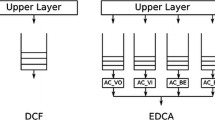Abstract
Different traffic types have different Quality of Service (QoS) requirements, which necessitate traffic prioritization enhancements in cellular networks. In CDMA2000 Evolution Data Optimized (EVDO) network, initial applications have been mainly focused on Best Effort (BE) traffic. Network operators observed that even though BE traffic users were the lowest priority users paying small subscription fees, they were heavily consuming the network resources. Therefore, operators demanded to charge BE users depending on their different levels of data usage. In this paper, we have designed a novel forward link (FL) scheduler to differentiate BE traffic users, and created new BE user classes with different throughput characteristics. Our new approach is called Inter-User Best Effort (IUBE) traffic classification and is implemented in CDMA2000 1xEVDO networks. The performance and characterization of designed scheduler is investigated through real network experiments conducted in live CDMA2000 1xEVDO network. TCP (Transmission Control Protocol) throughput measurements, received mobile terminal power, and signal-to-noise-plus-interference ratio (SNIR) were evaluated in the experiments. In conclusion, experimental data reveals that the average throughput value of a particular IUBE class user matches with its targeted IUBE class throughput value, and IUBE feature of CDMA2000 1xEVDO provides accurate traffic classification among BE traffic users in the cellular network.






Similar content being viewed by others
References
Andrews M (2001) Providing quality of service over a shared wireless link. IEEE Commun Mag 39(2):150–154
Bender P, Black P, Grob M, Padovani R, Sindhushayana N, Viterbi A (2000) CDMA/HDR: a bandwidth-efficient high-speed wireless data service for nomadic users. IEEE Commun Mag 70–77
CDMA2000 high rate packet data air interface specification. 3GPP2 C.S0024-A std. (2005)
How to ensure QoS in CDMA 2000 EVDO Rev A systems. QUALCOMM Inc. White Paper, March 2008. Online: http://www.cdg.org/news/events/cdmaseminar. Accessed 30 June 2010
Hui J, Devetsikiotis M (2004) CDMA2000 high rate packet data air interface specification. In: Proc. IEEE Globecom ’04
Knopp R, Humblet PA (1995) Information capacity and power control in single-cell multiuser communications. In: Proc. IEEE ICC’95, vol 1, pp 331–335. Seattle, WA
Rentel CH, Krzymien WA, Darian B, Vanghi V, Elliott R (2002) Comparative forward link traffic channel performance evaluation of HDR and 1XTREME systems. In: Proc. IEEE VTC’02, vol 1, pp 160–164. Birmingham, AL
Tse D, Viswanath P (2005) Fundamentals of wireless communication. Cambridge University Press
Yang SC (1999) CDMA RF system engineering. Artech House
Author information
Authors and Affiliations
Corresponding author
Rights and permissions
About this article
Cite this article
Sevindik, V., Bayat, O. & Weitzen, J. Traffic differentiation for BE users in CDMA 1xEVDO networks. Multimed Tools Appl 55, 507–523 (2011). https://doi.org/10.1007/s11042-010-0563-6
Published:
Issue Date:
DOI: https://doi.org/10.1007/s11042-010-0563-6




